Huawei P10 and P10 Plus: Performance & Battery Life Report
by Matt Humrick on May 12, 2017 7:00 AM ESTBattery Life
The Huawei P10 pairs the Kirin 960 SoC with a 3200 mAh (12.23 Wh) battery, a small capacity bump from the P9’s 3000 mAh unit. The P10 Plus, which also uses the Kirin 960, gets a battery capacity increase too, up from the P9 Plus’ 3400 mAh to 3750 mAh (14.33 Wh). In our analysis of Kirin 960, we were surprised to see a regression in power efficiency relative to last year’s Kirin 950/955, despite using the newer Cortex-A73 CPU cores that are supposed to consume 20%-30% less power than the Kirin 950’s A72 cores (same process, same frequency), according to ARM; however, the Mate 9 (Kirin 960, 4000 mAh battery) managed to improve battery life relative to the Mate 8 (Kirin 950, 4000 mAh battery) by saving power elsewhere, notably with a more efficient display. Did Huawei find similar power savings with its P10 and P10 Plus?
To find out, we’ll run them through our standard suite of battery tests. To make the tests accurate and repeatable, we control as many variables as possible, including minimizing background tasks and calibrating each display to 200 nits at 100% APL.
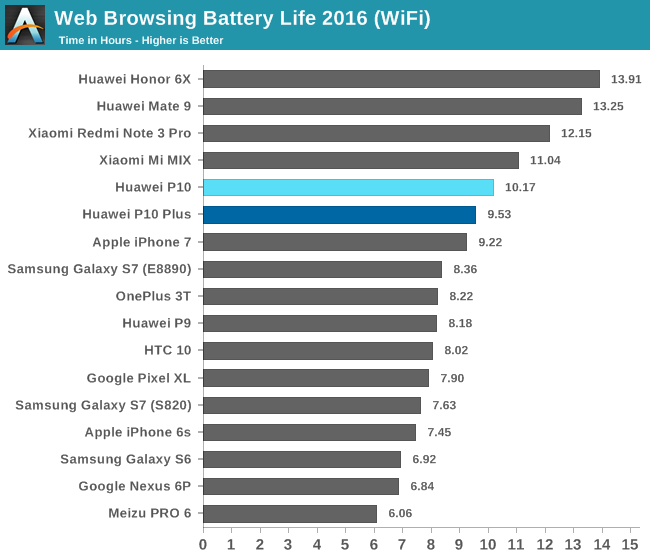
The P10 does quite well in our Wi-Fi browsing test that loads, pauses, and then scrolls through a set of popular websites while connected to Wi-Fi with the cellular radio turned off. Its 10 hours of screen on time is a 2 hour improvement on the P9. It definitely looks like Huawei has shaved power consumption from other components, because this increase is larger than what the bigger battery alone can explain. The P10 Plus uses more power on average than the P10 and its smaller, lower-resolution display, giving it just under 10 hours of screen on time in this test, which is still better than competing phones such as the Galaxy S7, OnePlus 3T, and Google Pixel XL.
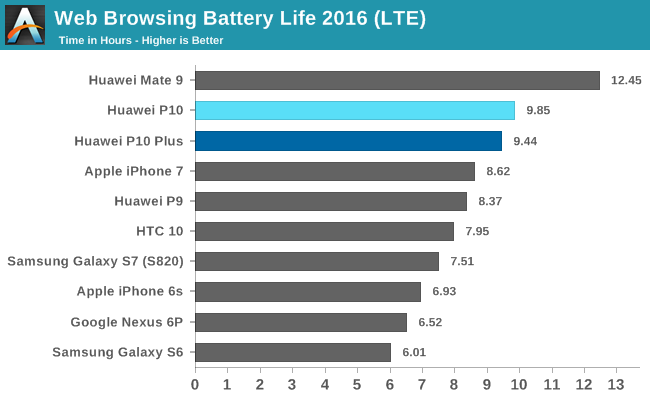
When using the cellular radio instead of Wi-Fi, the P10 once again lasts longer than the P10 Plus. The average platform power consumption (which is extrapolated from total runtime and battery capacity) is once again very similar between the P10 and Mate 9, with the P10 using 276-300mW less power on average than the P10 Plus.
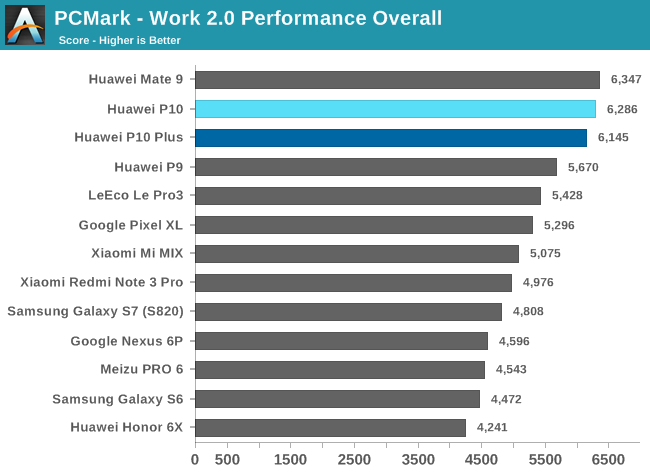
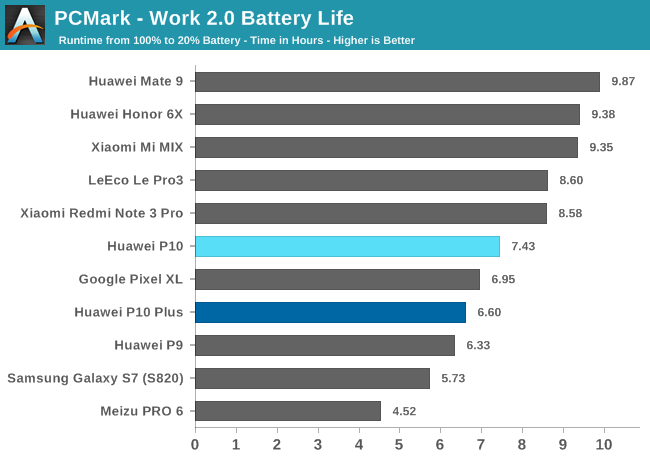
PCMark’s mixture of everyday workloads make better use of the CPU, GPU, and memory subsystems than our browsing battery life tests, which are still mostly limited by the power consumption of the display. With more work to do—and more frequent use of the big CPU cores and the GPU—the P10’s screen on time drops to just under 7.5 hours, a 1 hour improvement over the P9 and still a little longer than the Pixel XL. The P10 Plus only manages 6.6 hours, a far cry from the Mate 9’s nearly 10 hour duration. The Mate 9’s battery is only about 7% larger, but it lasts 50% longer in this test. Part of this difference is because of the particular Kirin 960 SoC in our P10 Plus sample, which draws more power than the parts in the P10 and Mate 9 (so a worse bin).


Most of the current flagship phones last around 3.5 hours when playing a game simulation like Manhattan ES 3.1, maybe a little longer if they have a larger-than-average battery. The P10 Plus only manages about 3 hours, the same as the P9, however. The smaller P10 dies about 15 minutes sooner, which is not a great result.
Of course we need to consider sustained performance too. As a general rule, the higher the performance the lower the battery life. The iPhone 7 is a good example; it delivers the best performance in this scenario but fails to match the battery life of its peers. The P10 sustains just over 18fps compared to about 9fps for the P9, so twice the sustained performance for only 15 fewer minutes of battery life. The P10 Plus manages just over 10fps sustained, similar to the P9, but it’s rendering onscreen at 1440p instead of 1080p like P9/P10. Factoring in display resolution, the P10 Plus offers similar sustained performance to other 1440p phones, such as the Galaxy S7, HTC 10, and Pixel XL, but falls about 0.5 hours short of these phones on battery life. The P10’s sustained performance is similar to the Le Pro3, OnePlus 3T, and Mi MIX, which all use lower-resolution 1080p displays, but it falls short on battery life, partially because these other three phones have larger batteries.
GPU Thermal Stability
The 1037MHz peak operating point Huawei uses for the Mali-G71MP8 GPU in the P10, P10 Plus, and Mate 9 is intended primarily for boosting benchmark scores and is not sustainable. All three phones only maintain peak performance levels for 1 minute (which just happens to be how long most graphics benchmarks last) before they begin reducing GPU frequency to avoid overheating. The P10 drops to 21fps after only 4 minutes, a 37% reduction relative to the peak value, before reaching equilibrium after about 30 minutes at around 18.3fps. This behavior is almost exactly the same as the Mate 9, except it drops to 21fps after 8 minutes and maintains 19fps afterwards, probably because its larger chassis can dissipate more heat. The P10 Plus also loses about 38% of its performance after 8 minutes.
The P10’s and Mate 9’s sustained performance is as good as or better than phones using Qualcomm’s Snapdragon 820/821 SoCs, though. The Moto Z Force Droid, with a newer GPU driver, can sustain a peak performance of almost 18fps for 12 minutes, gradually reaching a steady-state frame rate of 14.5fps, while the LeEco Pro 3, which uses a Snapdragon 821 SoC, can maintain 19fps after dropping from a peak value of 33fps. The Galaxy S7 edge also experiences a significant 33% drop in performance starting at the 8 minute mark, stabilizing at about 10fps after 31 minutes, similar to the P10 Plus’ 10.3fps when running at the same resolution.
Once the battery level drops to 10%, Huawei’s battery saving feature, which cannot be disabled, kicks in, reducing frame rate by more than 20%. There’s another step when the battery level hits 4%.
Battery Charging
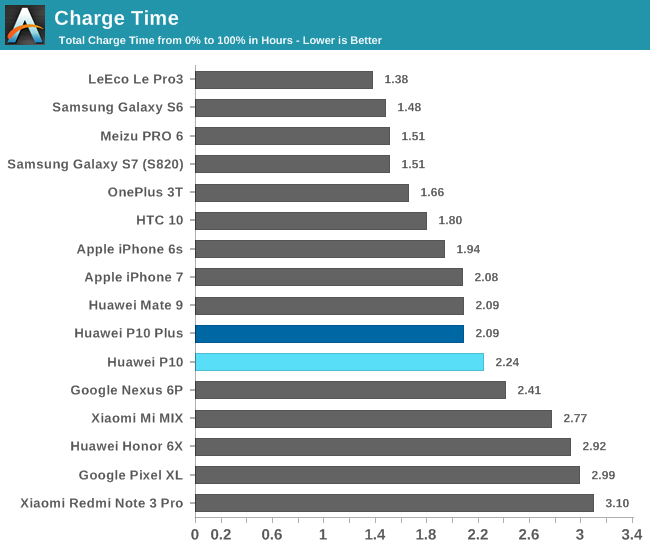
The P10 and P10 Plus include Huawei’s SuperCharge fast-charging technology that includes voltage, current, and temperature protection circuitry. The included wall charger is rated for 5V/2A (10W), 4.5V/5A (22.5W), and 5V/4.5A (22.5W) operation.
The P10 reaches a peak of about 16.2W at the battery shortly after being plugged in before settling around 12.5-13W. The battery charges to 25% in about 14 minutes and reaches 50% in about 31 minutes. The P10 Plus charges a little faster, initially spiking to 17.2W before settling around 14W. The P10 Plus’ battery charges to 25% in about 14 minutes and reaches 50% in about 30 minutes. Both P10s take just over 2 hours to be completely charged.



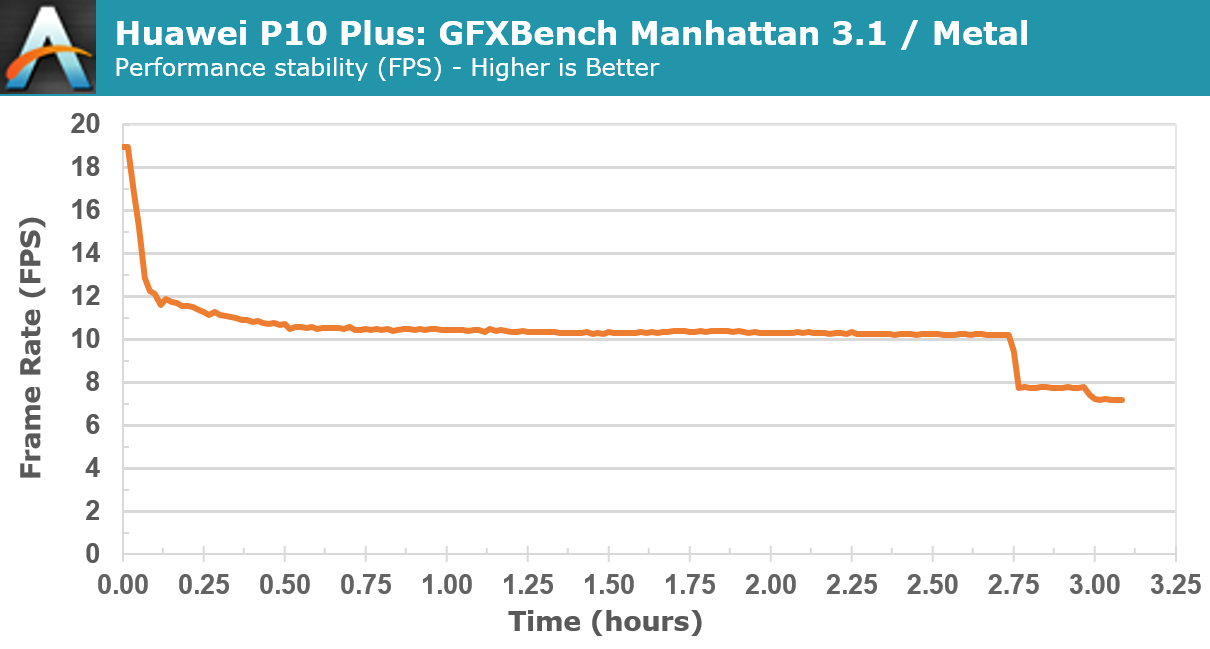
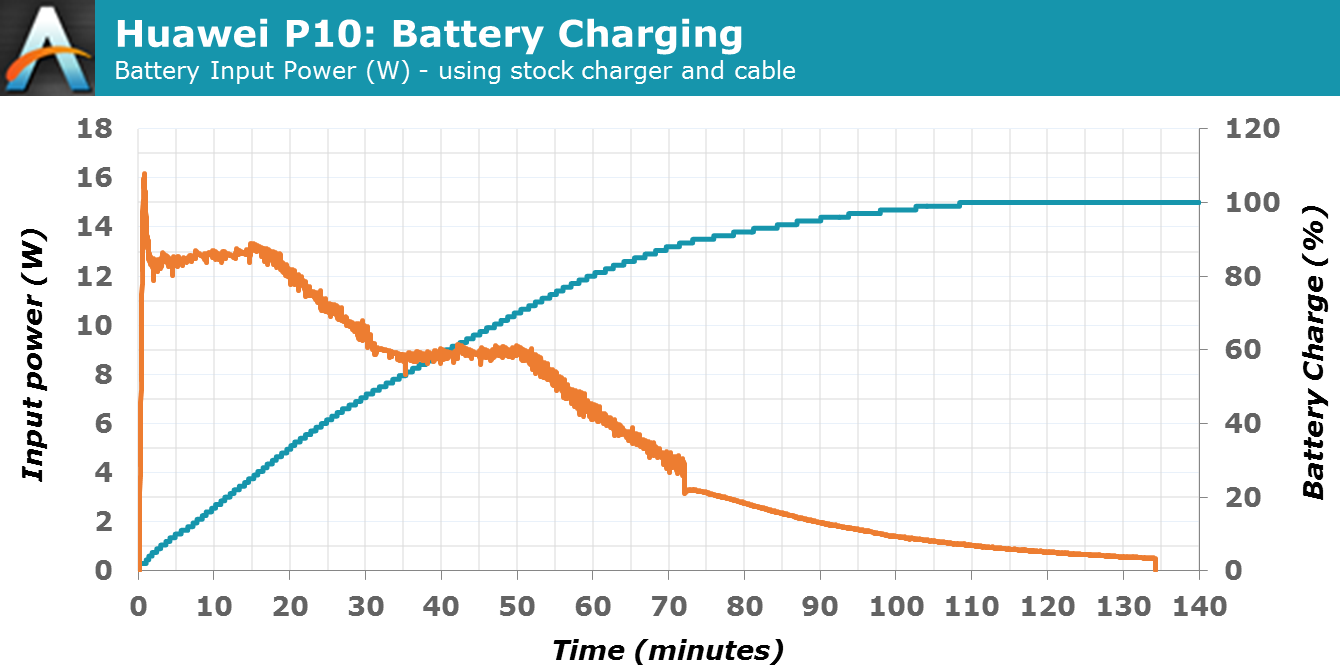
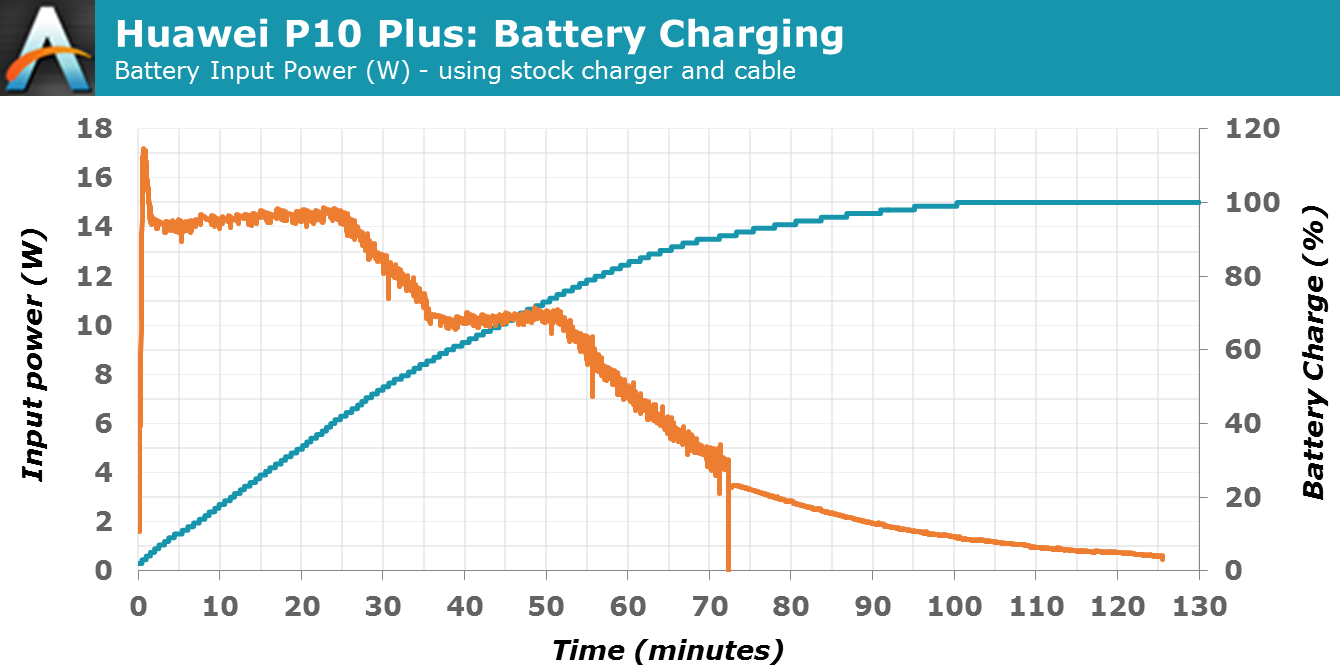








74 Comments
View All Comments
Matt Humrick - Sunday, May 14, 2017 - link
It looks like the idle power numbers you quote were measured with the screen brightness set to maximum, so they are not very useful. The Kirin 960 SoC does draw more power than the Kirin 950/955 as our analysis showed, though. There are several reasons for this that are specific to this SoC and are not software related.Trixanity - Sunday, May 14, 2017 - link
Hmm, that appears to be the case but it seems odd that both the P9 and P10 reviews would have maximum brightness and the others would not. Makes no sense to me but of course that's something to critique the author of and not you :)I don't recall there being device power consumption averages in your analysis. I would like to see how various devices do. We all see how the iPhone pulls incredible idle/standby numbers (in hours) but starts to falter during load (probably due to the smaller batteries) and we also see how Samsung generally does well in load scenarios due to reasonably efficient internals including advances in AMOLED efficiency giving them an edge while getting flak for poorly optimized software (Snapdragon variant especially) that ruins the user experience with stutters.
ePambos - Sunday, May 14, 2017 - link
Dear Matt, thanks for your suggestion. Haven't tried putting the P10 in Airplane mode overnight, cause I still need to have access to phone calls. But keep in mind that the P9 was operating in the very same conditions. I will try to test force-using other bands than 4G and check wether it is a signal strenght issue related to one specific band...ePambos - Friday, July 7, 2017 - link
Hi... Just an update. After the latest firmware update -which clearly stated right at the top "enchancement in battery life- I can attest to enormous difference in the battery life of my P10. Now it is directly comparable to the battery life I was getting from my P9. Latest version is VTR-L09C432B150... Is there any chance to re-run some test (including idle power consumption)? It would surely make for a pretty intereting read to see how just a firmware update affects battery life or performance...ePambos - Friday, July 7, 2017 - link
Hi... Just an update. After the latest firmware update -which clearly stated right at the top "enchancement in battery life- I can attest to enormous difference in the battery life of my P10. Now it is directly comparable to the battery life I was getting from my P9. Latest version is VTR-L09C432B150... Is there any chance to re-run some test (including idle power consumption)? It would surely make for a pretty intereting read to see how just a firmware update affects battery life or performance...rubene66 - Sunday, May 14, 2017 - link
I am still waiting for the complete galaxy s8 exynos review !tuxRoller - Sunday, May 14, 2017 - link
F2fs shouldn't be noticably faster than ext4 except when a program forces an fsync.The fs mount options matter more than the fs when it comes to these two.
asfletch - Wednesday, May 17, 2017 - link
Late to the party I know, but P10 just arrived in Australian stores, so I got to play with one yesterday. It does seem snappy, but I had more missed touches than I've had with any other (expensive) phone. The factory screen protectors were left on, but they're pretty thin so shouldn't have been the problem.I checked YouTube and some reviewers are also experiencing this - did you experience it at all Matt?
JohnLinc - Friday, May 19, 2017 - link
This phone is very good based on performance registered12345 righttehranbarbary - Tuesday, June 6, 2017 - link
<a href="http://tehranbarbary.com" >باربری تهران</a>